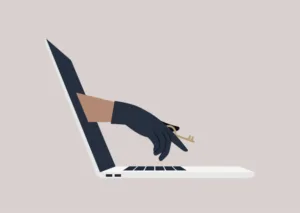Cybercriminals:

We lock our doors, avoid dark alleys, and take precautions in the real world. But when we spend a growing chunk of our lives online, many of us wander through the digital landscape with wide-open doors. According to Statista, the cost of cybercrime‘ in the cybersecurity market was forecast to continuously increase between 2023 and 2028. But who exactly are the cybercriminals behind the screens?
Cybercriminals: A Look at the Shocking Truth
Cybercriminals might seem like shadowy figures in dark basements, but the truth is often more surprising.
Here are 10 mind-blowing facts about cybercriminals that will change your perception of this ever-growing threat:
1. Not all cybercriminals are tech geniuses.
Hollywood paints cybercriminals as hoodie-wearing masterminds with superhuman coding skills. But the reality is far less glamorous. Many cyberattacks rely on readily available tools and exploit kits sold on the dark web. Social engineering, which manipulates people into giving up information, is another popular tactic that requires more cunning than complex coding.
2. They don’t just target big businesses.
While headlines often scream about breaches at major corporations, small and medium-sized businesses (SMBs) are more vulnerable. SMBs often have fewer cybersecurity resources and are just as attractive targets for stealing customer data or disrupting operations.
3. They’re not all about money.
Financial gain is a major motivator, but it’s not the only one. The motivation for cybercriminals can range from activism to creating chaos by disrupting corporate systems or the government. Others may want personal information for identity theft, or they may simply enjoy the challenge of breaking into secure systems.
4. They can be insiders too.
A significant portion of data breaches involve insiders—disgruntled employees, contractors, or even business partners with access to sensitive information. This highlights the importance of strong access controls and security awareness training within organisations.
5. Cybercrime is a global business.
Cybercrime transcends borders. Hackers can operate from anywhere in the world, making it difficult for law enforcement to track them down. This is why international cooperation and information sharing are crucial in combating cyber threats.
6. They’re evolving faster than our defences.
Cybercriminals are constantly innovating, developing new techniques and exploiting emerging technologies like artificial intelligence and the Internet of Things (IoT) to launch attacks. Staying ahead of the curve is a constant challenge for cybersecurity professionals.
7. The “Mom-and-Pop” hacker shop is gone.
Cybercrime is becoming increasingly professionalised. There are now well-established cybercrime groups offering “cybercrime as a service“—hacking tools, malware, and even targeted attacks—available for purchase on the dark web.
8. They find social media to be a gold mine.
The information we share on social media—our birthdays, locations, pet names—can be a goldmine for social engineering attacks. Cybercriminals can use this information to craft personalised attacks that appear more believable.
9. They’re Not Above Targeting Individuals
While businesses are prime targets, individuals are also at risk. Phishing emails, smishing (SMS phishing), and malware-laden attachments are all tactics used to steal personal information, login credentials, and financial data.
10. The Internet of Things (IoT) Creates New Risks
With billions of connected devices, the IoT expands the attack surface. Hackers can exploit vulnerabilities in smart TVs, thermostats, and other devices to launch attacks or steal data. Securing your entire digital ecosystem is essential.
Read More: Cybersecurity Awareness: How to Empower Your Employees
Unveiling Tools for Detecting Cybercriminals

While cybersecurity tools can’t directly identify cybercriminals, they can be instrumental in detecting their activity and protecting yourself from their attacks. Here’s a breakdown of some helpful categories:
1. Network Security Tools:
i. Firewalls: These act as a barrier between your device and the internet, filtering incoming and outgoing traffic for suspicious activity.
ii. Intrusion Detection/Prevention Systems (IDS/IPS): These monitor network traffic for malicious behaviour and can either alert you or automatically block suspicious attempts.
iii. Vulnerability Scanners: These tools scan your systems for weaknesses that cybercriminals might exploit.
2. Endpoint security tools:
i. Antivirus/Anti-malware Software scans your devices for malicious programmes and can quarantine or remove them.
ii. Endpoint Detection and Response (EDR): These advanced tools provide real-time monitoring and analysis of endpoint activity to detect and respond to threats.
3. Threat intelligence tools:
i. Security Information and Event Management (SIEM): These systems collect and analyse data from various security tools, providing a comprehensive view of potential threats.
ii. Cyber Threat Intelligence Feeds: These services provide real-time information about the latest cyber threats and vulnerabilities, allowing you to stay proactive.
4. Additional Tools:
i. Password Managers: They create and store strong, unique passwords for all your accounts, reducing the risk of breaches due to weak passwords.
ii. Email Security Tools: These tools can filter out phishing emails and other malicious messages before they reach your inbox.
Remember, these tools work best when used together to create a layered defence. It’s also important to stay informed about the latest threats and update your security software regularly.
Read More: Understanding AI-Powered Cyber Threat Analysis
Steps You Can Take to Protect Yourself from Cybercriminals

Here’s the good news: You don’t have to be a helpless victim. By following some basic cybersecurity practices, you can significantly reduce your risk of falling prey to cyberattacks. Here are some key steps:
i. Use strong, unique passwords for every online account and enable two-factor authentication (2FA) wherever possible.
ii. Be cautious about clicking on links or opening attachments in emails, even from seemingly familiar senders.
iii. Keep your software and operating systems up to date with the latest security patches.
iv. Beware of free Wi-Fi hotspots and avoid conducting sensitive transactions on public networks.
v. Educate yourself about common cyber threats and scams.
Understanding the evolving landscape of cybercrime and taking steps to protect yourself can help you navigate the digital world with more confidence. Remember, even small changes in your online behaviour can make a big difference.
Read More: How Threat Analysis Tools Can Crack Cyber Crimes
Conclusion
Understanding cybercriminals and their motivations is crucial for developing effective cybersecurity strategies. By being aware of the tactics they use and the vulnerabilities they exploit, we can take steps to protect ourselves and our valuable data. Remember, cybersecurity is a shared responsibility. By working together, we can create a safer digital world for everyone.
Bonus Tip: Stay updated on the latest cybersecurity trends and best practices. Many reputable organisations offer free resources and educational materials to help you stay informed. Stay safe out there!










